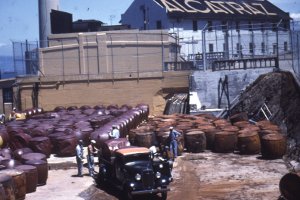 Getting power to Alcatraz is its own special conundrum. At various stages of its existence, the island has run on coal, wood, bunker oil, and now diesel fuel, all ferried from the mainland. Image courtesy of the Golden Gate NRA, Park Archives.
Getting power to Alcatraz is its own special conundrum. At various stages of its existence, the island has run on coal, wood, bunker oil, and now diesel fuel, all ferried from the mainland. Image courtesy of the Golden Gate NRA, Park Archives.
Getting anything to Alcatraz Island has always been a headache. Whether it was 10,000 muskets to the military outpost in the 1850s, dirty laundry for prisoners to wash in the 1950s, or 5,000 daily tourists this year, nearly everything animal, vegetable, or mineral on Alcatraz gets there by boat.
This makes Alcatraz a great example of green-ness by necessity. The less efficient you are out there, the greater the hassle factor. Take water, for instance: Every drop of it -- for toilets, for water fountains, for the historic prisoners' gardens -- must come in from the mainland. So, staff here not only bring their dirty dishes home to wash at the end of the day, they've built a rainwater catchment system to irrigate the gardens.
Getting power to Alcatraz is its own special conundrum. At various stages of its existence, the island has run on coal, wood, bunker oil, and now diesel fuel, all ferried from the mainland. At one point, in the early 20th century, the boats got a brief respite when workers lay cables under the bay to connect Alcatraz to the mainland grid. That experiment ended when boats snagged the cables, leaving Alcatraz once again in the dark.
When the Obama Administration announced $750 million dollars in stimulus funds for the National Parks System, Park officials glimpsed a rare opportunity to solve (or at least mitigate) this problem once and for all. The new solar panels on the island are expected to cost somewhere between $5-10 million, and will be installed in late summer. (That's less than half the estimate, by the way, that engineers gave for digging trenches under the Bay to once again lay cables connecting Alcatraz to PG&E lines.) Once it's up and running in Summer 2011, the system will supply more than half the island's electricity needs.
